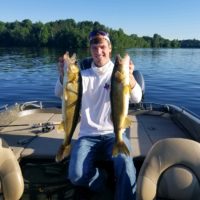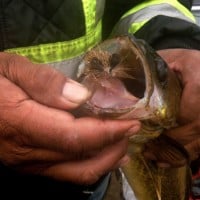Reflecting back on the open water season, my son and I had an experience I’d like to share. It was very unique and falls nicely into the subject of this older thread. Perhaps some may find the experience interesting or of benefit in the future when faced with similar conditions. If you have an interest and a couple of spare minutes, allow me to tell the story.
The setting was early July in northern Minnesota. The day was sunny and warm. More importantly, the lake was in the middle of a massive mayfly hatch. Carcasses and mayflys were floating in slicks everywhere the eye could see.
That morning, we got on the water early and already had had a couple hours of very good walleye fishing, primarily rip-jigging flukes. Since we were up at the cabin with our significant others, we decided to return for breakfast to fulfill our social obligations.
We made one last stop near the cabin when we noticed seagulls, lots of seagulls, excitedly diving on a 13’ flat nearby. We decided to check it out.
Approaching the area, we noticed quite a bit of surface activity going on. Besides all the birds diving, fish of some sort – we didn’t know what species or think much of it – were obviously feeding in this area. The food chain was definitely in high gear.
Idling thru this zone of life, the side imaging lit up. Stopping the boat, we stood up and fired casts with big swim baits in the direction indicated by the birds and our electronics. What happened next shall not soon be forgotten.
My swim bait hadn’t sank for more than a second or two after splashdown when it was engulfed by a big walleye. My son had a similar experience. For the next 45 mins or so, we hooked or caught walleyes on nearly every cast – big walleyes for this body of water. It was almost heaven.
At one point, we doubled-up. I got my fish in more quickly than Jeff and fired another cast, immediately hooking-up with another fish while he continued to fight his original fish. A ‘triple’ by only two anglers. Yes, it was that ridiculous. We had stumbled onto something really, really special and feel super grateful for having somewhat lucked into this experience.
Once we had stopped the boat, it became quite apparent that the surface activity we saw was being caused by walleyes. These walleyes weren’t acting like the walleyes we’re all a custom to reading about and catching using bottom bouncing presentations. These walleyes were literally somersaulting completely out of the water while in pursuit of high-riding perch, who themselves were feeding at the surface on floating mayflies. Surface explosions were happening all around the boat, for a hundred yards or more in every direction. On another body of water, you could have mistaken it for a huge school of stripers or white bass feeding on the surface – except these were walleyes.
At one point my son turned to me and said, “Dad, there’s 10 acres of walleyes around us!” He was right. The spot now has a new and permanent name…the 10-acre shoal.
Preceding many of these surface explosions, the walleyes would be pursuing perch just under the surface, creating large wakes similar to when muskies follow a surface bait. We could actually ‘lead’ these waking fish with our next casts. Seeing this, Jeff got an idea and tied on a Zara Spook in an unsuccessful attempt to catch these walleyes on a surface bait. The fish’s indifference was surprising considering how aggressively they were feeding. We theorize the Zara Spook would have been more successful if perch patterned – which it wasn’t. Back to the swimbait and back to catching.
Peering down into the water, we began to actually see big walleyes hunting. They were swimming under and around the boat in small schools, just under the surface pursuing yellow perch that were on the surface and fleeing for their lives. Just having eyes on big walleyes actively hunting was a very cool thing to witness.
While we had the boat in 13’ of water, the hot depth zone was 0’ to 3’. If our baits were allowed to sink beyond that depth, we were fishing under the fish and not getting bit as well. The best presentation was to cast that big swimbait and, upon splashdown, immediately begin retrieving at a high rate of speed to emulate those fleeing perch. The strikes came easily and were bone jarring.
So, while we were having the day-of-all-days on ’The 10-Acre Shoal’, there were no less than three or four other walleye boats in the immediate area, fishing quite close to us. They were all slow trolling or drifting with live bait on the bottom. They caught nothing while we were there. In fact, it wouldn’t surprise me if the anglers in these boats thought we were Muskie fishing, given the size of our baits and the speed of our retrieves.
Later, general fishing reports around the lake for the weekend were along the lines of ‘slow fishing due to the bug hatch’. Well, the walleyes weren’t full from eating all the available bugs. We knew first-hand they were feeding heavily on the smaller fish that were eating the bugs – primarily yellow perch. The food chain had simply shift to the surface and was in very high gear due to the bug hatch. I’m guessing most walleye guys did not make the vertical or presentation speed adjustments to capitalize on this unique opportunity. They were fishing underneath the walleyes, with baits too small, fished too slowly.
In summary, this is now our second experience with surface feeding walleyes. Can it be repeated and patterned? Maybe. Time will tell, but this story may contain some nuggets that could help make that happen in the future. Hopefully, you enjoyed reading about this rare experience as much as I enjoyed re-living it. We were very fortunate that day no doubt. To be there with my son made it extra special. That’s him in the photo, holding a couple of typical fish we caught that magical hour.
Attachments:

6F39194B-C381-445A-8187-CBD9F8855558.jpeg

